Paris's Louvre will welcome visitors back on July 6, months after the coronavirus pandemic caused its closure in March.
With the reopening, the museum has established some new rules and restrictions, such as the mandatory use of face masks for everyone above the age of 11. Hand sanitiser will be provided at the two entrances and one-way entry systems have been put in place. Visitors must also follow a guided path through the museum.
All visitors, including those eligible to free entry, must book a time slot online beforehand in order to gain access. The Louvre's website states that same-day visits may be available for booking at the museum for off-peak hours, though entry cannot be guaranteed this way.
The coat check service will not be available, and items such as suitcases and large bags will not be allowed inside the building.
The Salles des Etats, which is the area around Leonardo da Vinci's Mona Lisa, has been marked with socially distanced positions where tourists can pose for pictures. The area will have separate entry and exit points.
About 45,000 square metres, or 75 per cent, of the museum's public areas will also be open to the public. The bookstore and catering services, along with the Carrousel and Tuileries gardens will also be open.
Printed maps will not be available at the museum, but Louvre has shared its map for summer 2020 on its website.
Certain areas have been closed to the public, including the galleries for the arts of Africa, Asia, Oceania and the Americas, as well as the lower level of the Islamic Art department. Visitors can still enter the areas for the Near Eastern, Egyptian, Greek and Roman antiquities, the introduction to Islamic Art, as well as the Italian, Spanish and English paintings and 19th-century French masterpieces.
Ahead of its public reopening, the museum welcomed photographers for its online marketing campaign #LouvreAtFirstSight. Some of the photographers shared images of the Louvre's empty halls and galleries on their Instagram pages.
Louvre's exhibitions for the spring have been postponed to later this year, including shows on German Renaissance painter Albrecht Altdorfer and Italian sculpture (featuring works by Donatello and Michelangelo). The former will open in October of this year, while the latter has been postponed to January.
The museum is also preparing for an overhaul of curation and presentation of its collections in the lead up to the 2024 Olympics in Paris.
Since shuttering in March, the world's most visited museum has experienced significant financial setbacks. Museum director Jean-Luc Martinez approximated it to "losses of over €40 million [Dh165.1m]" due to lost ticket revenue.
“We have lost 80 per cent of our public. Seventy-five per cent of our visitors were foreigners,” he said. In 2018, Louvre welcomed 10 million visitors, three-quarters of which were tourists.
Martinez added that he expects to see footfall drop by 20 to 30 per cent compared to last summer’s figures, “between 4,000 and 10,000 visitors daily at the most".
Of Louvre's €250m budget, the French government contributes €100m, as reported by AFP. The remaining amount is covered by the museum.
As of Sunday, France has recorded a total of 166,960 confirmed cases.
The country began welcoming visitors from a number of EU nations in June. Since Wednesday, July 1, the EU has allowed tourists from 14 approved countries, including Algeria, Morocco, Tunisia, Australia and Canada, to enter. At the time of writing, the UAE has not been included in the list.


